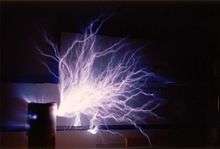Brush discharge

.jpg)

A brush discharge is an electrical disruptive discharge similar to a corona discharge that takes place at an electrode with a high voltage applied to it, embedded in a nonconducting fluid, usually air. It is characterized by multiple luminous writhing sparks, plasma streamers composed of ionized particles, which repeatedly strike out from the electrode into the air, often with a crackling sound.[1][2] The streamers spread out in a fan shape, giving it the appearance of a "brush".
Corona and brush discharges are sometimes called one-electrode discharges because they occur in the vicinity of a single electrode, and don't extend as far as the other electrode, as in an electric arc (a two-electrode discharge).
- Corona discharge — occurs at sharp points and edges (radius < 1 mm). It is a uniform ionization (glow discharge) visible as a dim stationary blue glow, fading out as it extends from the conductor.
- Brush discharge — occurs at a curved electrode (radius between 5 and 50 mm)[3] in the vicinity of a flat electrode. It consists of a short ionization channel which breaks up into a fan of multiple moving streamers which strike toward the other electrode. Brush discharges can occur from charged insulating plastics (for example polythene) to a conductor.
- Arc or spark discharge — A "two electrode" discharge that occurs when an ionized channel extends all the way from one electrode to the other.[4] This allows a large current to flow, releasing a large amount of energy.
Both brush and corona discharges represent regions next to conductors where the air has ionized and become conductive, allowing current to leak into the air. They occur when the electric field at the conductor exceeds the dielectric strength of the air, the "disruptive potential gradient", roughly 30 kilovolts per centimeter. At that voltage, electrons in the air are accelerated by the electric field to a high enough velocity that they knock other electrons off gas atoms when they hit them, creating ions and additional electrons, which go on to ionize additional atoms in a chain reaction. Because the electric field decreases as the distance from the conductor increases, it eventually drops below the value needed for ionization, so corona and brush discharges have a limited extent and are localized near the conductor.
The ability of an electrical discharge to cause an explosion in flammable atmospheres is measured by the effective energy of the discharge. The effective energy of brush discharges is 10-20 mJ, much larger than that of corona discharges 0.1 mJ. Therefore brush discharges are considered an explosion hazard, while corona discharges are not.
See also
References
- ↑ Kaiser, Kenneth L. (2005). Electrostatic Discharge. CRC Press. pp. 2.73–2.75. ISBN 0849371880.
- ↑ Britton, Laurence G. (2010). Avoiding Static Ignition Hazards in Chemical Operations. John Wiley. pp. 20–24. ISBN 0470935391.
- ↑ Kaiser, Kenneth L. (2005-09-22). Electrostatic Discharge. CRC Press. ISBN 9780849371882.
When the electric field near an electrode with a radius or curvature between about 5 mm and 50 mm is sufficiently large (about 500 kV/m). irregular multiple discharge paths are seen that have the look of a brush. ... If the electrode is too sharp, a corona discharge will usually occur instead of a brush discharge.
- ↑ Banerjee, Sanjoy (2002-11-27). Industrial Hazards and Plant Safety. CRC Press. ISBN 9781560320692.
Spark discharge occurs in a sudden burst that bridges the gap between two conductive surfaces, each with a radius of curvature > 50 mm. On the other hand, brush discharges fail to bridge the gap and occur in rapid succession, giving the impression of a brush. Corona discharges form a luminous region around a conductor and discharge continuously for regions with a radius of curvature < 1 mm.